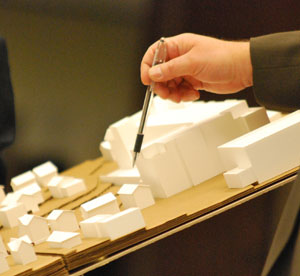Six-Vote Majority Leaves The Moravian Short
Ann Arbor City Council meeting (April 5, 2010) Part 1: In a six-to-four vote on Monday night, the Ann Arbor city council did not give The Moravian development the required 8-vote super-majority it needed for approval. A petition signed by greater than 20% of adjoining property owners meant that the project needed eight instead of the six votes it actually received to win the council’s endorsement.

On an architect's scale model of the neighborhood, Tom Luczak points to a house on Fourth Avenue, next to the proposed project, The Moravian. The view is roughly from the northwest. Luczak spoke in opposition to the project. (Photos by the writer.)
The five-story, 62-unit building proposed for the section of East Madison Street between Fourth and Fifth avenues near downtown Ann Arbor had come before the council with the recommendation of the city’s planning staff and a 7-1 vote recommendation from the city’s planning commission.
The public hearing on The Moravian included remarks from around 90 people on both sides of the issue. The Moravian alone – counting the public hearing, plus the deliberations by the council – took up over four hours of the meeting, which lasted well past 1 a.m.
Besides The Moravian, the council’s business included an item that would have reconsidered its recent decision to replace the entire Ann Arbor housing commission board. The motion for reconsideration was voted down, with no support, not even from its two sponsors – Stephen Kunselman (Ward 3) and Mike Anglin (Ward 5). Kunselman cited the late hour as part of the reason for his lack of enthusiasm for pursuing the matter.
The council also tabled a proposed city ordinance that would ban cell phone use while driving. The council had postponed the measure to a specific date a few times previously. The tabling means that the ordinance can be brought back for consideration by the council, but by council rule it will die unless it is brought back within six months.
Also receiving brief discussion was a possible council rule on email that the council is now forced to consider publicly at its next meeting under terms of a recent lawsuit settlement.
In Part 1 of this report, we focus exclusively on The Moravian. [Full Story]




